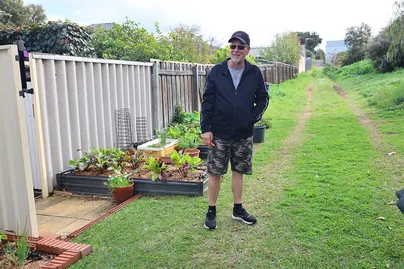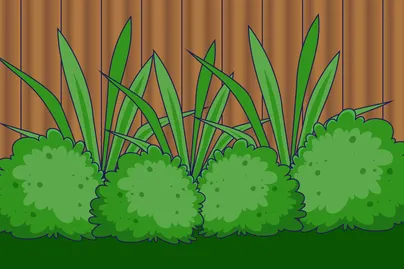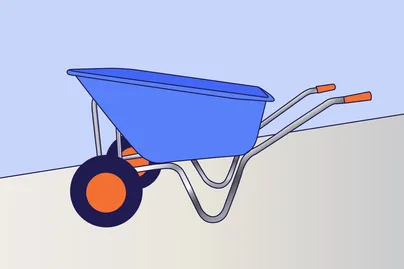Here are some ideal gardening tools for older people. With a few changes and the right tools, you can keep enjoying your time in the garden for years to come!
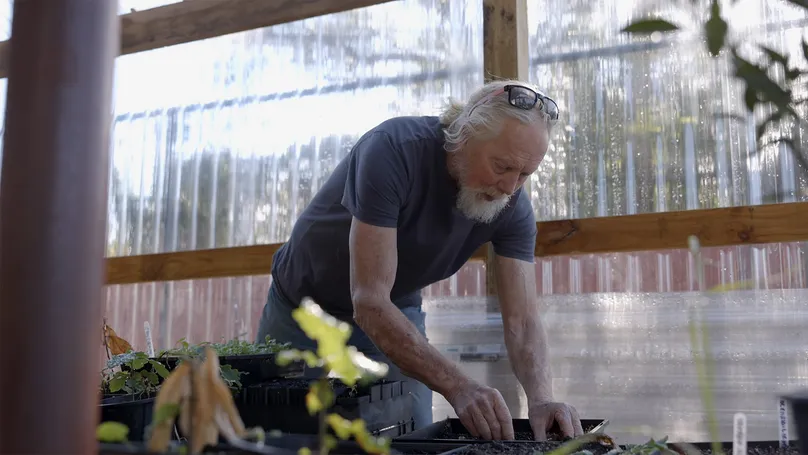
Gardening tool recommendations
Make life easier with adaptive gardening tools for older people.
Bending and kneeling
Here are some helpful tools and tips to reduce the impacts of bending and kneeling in the garden.
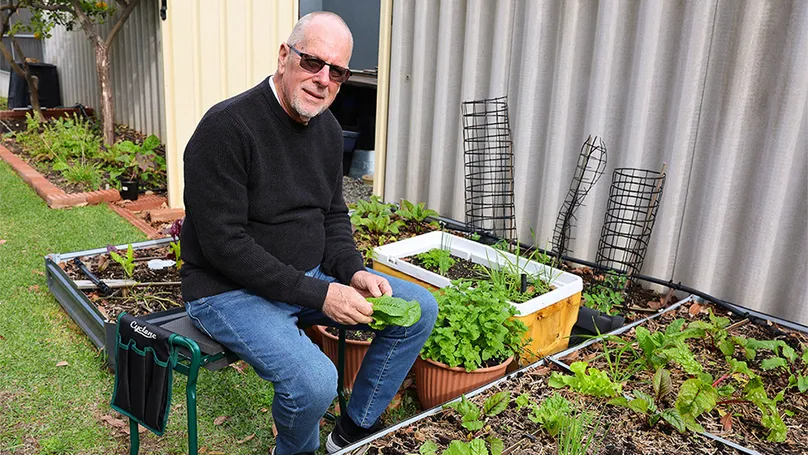
Kneel or sit on something soft. Large kneeling pads or knee pads provide a softer place for your knees to rest when kneeling. This can help minimise joint pain. A garden seat and kneeler can also allow you to sit and kneel comfortably in your garden.
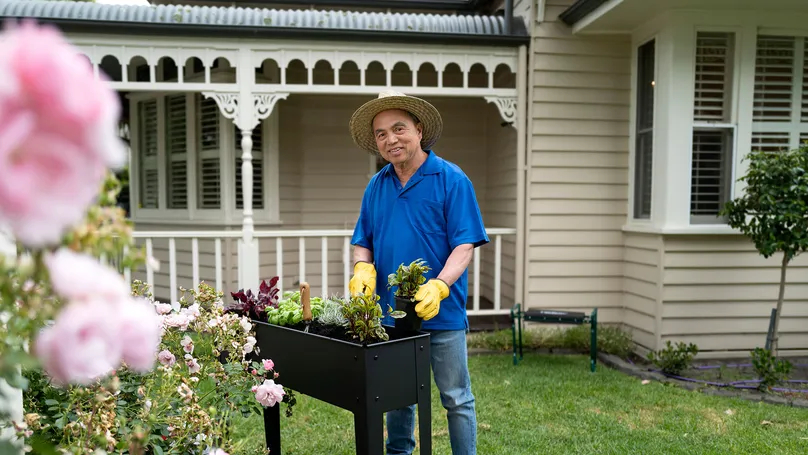
Bring your garden up to you! Vertical wall gardens, pot-plant stands, and raised garden beds all help to reduce bending and kneeling. These tools allow you to keep your plants at a height you can reach while standing.
Reach further with mid-length and long-handled tools. You can also reduce the need to bend or kneel by using longer-handled tools. Mid-length gardening tools are useful for reaching into lower garden beds from a seated position or working in raised beds while standing. Long-handled gardening tools such as long-handled weeders are perfect for reaching the ground while standing. You could also use a long-handled grabber to pick fruit that are too high up to reach.
Pushing and carrying
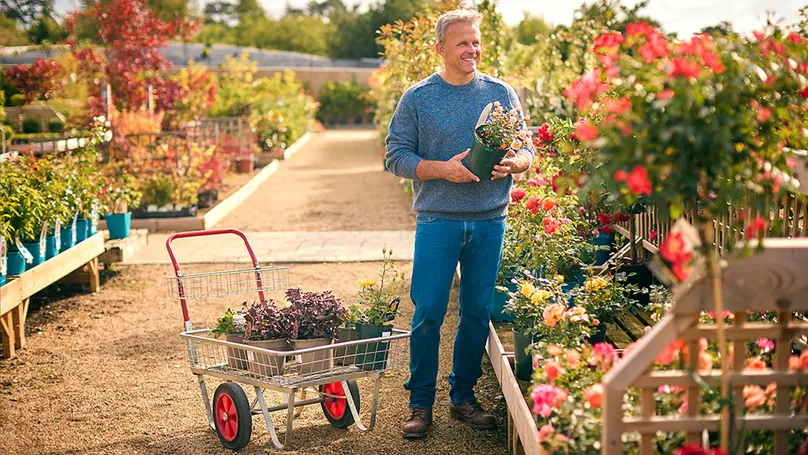
Do you find it difficult to push wheelbarrows or carry heavy pots through your garden? Consider some of these helpful tools to make moving things around easier:
- A gardening trolley allows tools and equipment to be easily gathered together and wheeled to where you are working.
- A pot trolley helps you move garden pots around without bending or lifting.
- Portable ramps will help you move trolleys and wheelbarrows over steps.
- A two-wheeled wheelbarrow can be easier to pull around than a one wheeled one. This means less strain when pulling and pushing.
Tools to help your hands while gardening
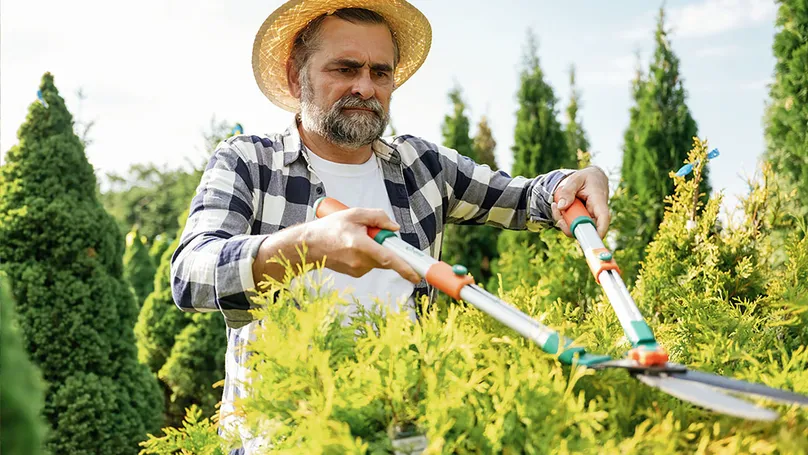
You can help your hands by strengthening them with the exercises and using tools that reduce pain.
There are lots of different tools you can buy. If possible, try the tool before you buy it. This will help you feel how it fits in your hand, how heavy it is, and how easy it will be for you to use.
Here are some different types of tools to help your hands while gardening:
- Light and ergonomic hand tools, such as easy-grip secateurs, are designed to prevent hand and wrist strain. This can help make gardening activities more comfortable for you. Just remember, it's still important to take regular breaks.
- All-purpose pick-up tools help you pick up small items in the garden without having to bend down. These can include pots and seedling punnets, as well as garden rubbish.
- If reaching is difficult try a watering wand, long-handled fruit picker, and mid-length to long-handled gardening tools. These can help you do any gardening that requires reaching or using a ladder.
- Ratchet pruners are helpful if you have limited grip strength. This type of tool is easy to squeeze while still giving good cutting power.
- Alternative options for pruning include left-handed secateurs, Fiskars Plus pruners, and the Fiskars SoftGrip Pruner which is suitable for small hands.
Products to help you see and remember
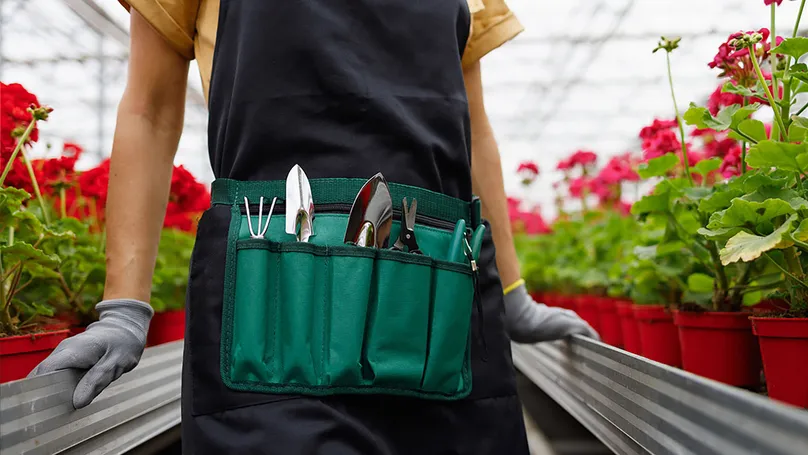
Use adaptive techniques to keep track of all your garden tools and tasks:
- Use a garden trug (basket), brightly coloured bucket, or a gardening apron with large pockets to hold hand tools and to gather weeds as you go. This can also help you remember where your gardening tools are.
- Tools with colourful or fluorescent handles are easier to find if you have low vision or are forgetful sometimes.
- Use plant tags and labels help to keep track of plants in the garden. Copper plant labels can be embossed with raised lettering or Braille.
- Invest in watering systems and self-watering pots. This means less work for you every day.
- Store your tools on peg boards or a canvas hanger. This makes them easy to find when you need them.
- Get wall charts and a plant journal to help you keep track of your gardening.
Make gardening easier and safer
Gardening is great for healthy ageing. It's one of the most popular recreational activities in Australia. And there are good reasons for this. Gardening can have many physical and mental health benefits:
- Digging, pulling, sweeping, and raking are all forms of resistance aerobic exercise. That means it strengthens your muscles while also getting your heart pumping.
- Kneeling down and standing back up takes flexibility, strength, and balance.
- Pruning requires strong grip and hand control.
- Gardening can be a source of pleasure and relaxation.
- Being around plants, or outside in nature, can make you feel good.
However, older gardeners may have health conditions such as arthritis which make gardening more difficult. Luckily, there are many tools and products to make gardening easier and safer.
For example, you could use a garden trolley or bucket to hold what you use most of the time. This means you’ll always have what you need close at hand to keep up with garden maintenance.
Safety and protective products are also important. E.g. gloves (including gloves with arm sleeves or long gauntlets), safety glasses, face masks, ear defenders, boot guards, and sunscreen.
You can also take care of yourself by doing a little bit of gardening more often, rather than a lot all at once:
- Pull up a weed or two on your way to the letter box.
- Dead head the roses as you walk around the garden.
- Do light pruning when you first notice what needs attention.
Doing a little bit here and there can make gardening more manageable.
Using gardening tools
Here are some tips for using tools to efficiently:
- Get in the habit of carrying secateurs with you when you go out into the garden.
- Keep your favourite tools stored at waist height. This means less bending and reaching.
- Use a shadow board or a canvas hanger to sort and store your hand tools and small gardening items.
- Get rid of damaged tools or tools that you don't use. Replace them with light and ergonomic tools.
- Look for easy-to-use solutions to manage difficult tasks. For example, a self-winding hose reel reduces the risk of tripping on a garden hose left on the ground.
- Manage heavy items with tools like a folding ramp, sack truck, and dump cart.
Prepare your body for gardening
Gardening is a great form of physical exercise, and with all exercise you need to think about how you’re going to get started. Here are some tips for avoiding pain and injury:
- Do warm-up stretches before and after gardening. This helps prepare your body for the work ahead and for winding down afterwards.
- Wear shoes that will support your feet and protect them. Wearing supportive shoes while gardening can also help reduce your risk of falls.
- Stay sun safe. In warmer weather, garden early in the morning and late in the afternoon to avoid high temperatures.
- Stay hydrated, especially if moving around and working up a sweat. Take a bottle of water outside with you, or make sure you’re going inside regularly to have a glass of water.
- Keep a chair and your bottle of water nearby (ideally in a shady area) so that you can stop for breaks, even if you don’t think you need to.
- Alternate your gardening jobs and limit your time on repetitive tasks. This will help reduce stress on your joints and muscles.
- Mix gardening jobs that require bending with standing tasks to avoid getting stiff.
Adapt your garden
Gardening is all about change. If you plan to stay in your home, it’s worth making the changes to make enjoying your gardening easier.
Make a list of the jobs you need to do regularly, and the jobs you do less often. With some planning you can adapt your garden in stages. If you can, pay for professional help with a garden redesign for low maintenance, accessibility, and safety.
Mature gardens can sometimes be easier to maintain. You may only need to pay for help with jobs like lawn mowing, pruning vines, and hedges. Robotic lawnmowers are good for lawns that don’t have many obstacles. Some new brands can also apply fertiliser and do mulching.
Simple ways to adapt your garden:
- Keep established trees and shrubs but remove low-level plants.
- Plant low-maintenance garden beds with suitable natives, grasses, and hardy ground covers.
- Plant perennials rather than annuals and use plants with the same fertiliser and water needs.
- Mass plant one variety suited to the existing light and soil conditions. This is often what landscapers do to create visual impact in a large area.
- Maybe replace thirsty outdoor pot plants with succulents or hardier plants bred for growing in pots.
- Install automatic watering systems to take care of your garden and cut down on hand watering.
Indoor gardening
If an outdoor garden is too difficult to maintain, consider keeping a more manageable 'indoor garden' instead. Houseplants have been shown to inspire creativity and foster a connection with nature. They give us relief in closed spaces by making the environment more pleasant. Research has shown that keeping indoor pot plants can be good for your health, too.
Here are some of the health benefits of houseplants:
- Improving indoor air quality
- Reducing stress and anxiety
- Lifting your mood and recharging you
- Improving your recovery from an illness, injury, or surgery
An occupational therapist can help you with gardening
An occupational therapist (OT) can help you:
- Adapt tasks to stay independent
- Simplify your work in the garden
- Find products that make it easier for you to maintain your garden
- Protect your joints and manage any pain you might experience
Find an OT in your local area with the search tool on the Occupational Therapy Australia website.
Get in touch with LiveUp
Call 1800 951 971 for more ways to enjoying gardening. Get free information on community gardens, gardening clubs, open gardens, and horticultural shows. We can help you connect with gardening and other gardeners.
References
Stanborough, R.J. (2020, Sept 18). What are the benefits of indoor plants? Healthline. https://www.healthline.com/health/healthy-home-guide/benefits-of-indoor-plants
Howarth, M., Brettle, A., Hardman, M., & Maden, M. (2020). What is the evidence for the impact of gardens and gardening on health and well-being: A scoping review and evidence-based logic model to guide healthcare strategy decision-making on the use of gardening approaches as a social prescription. BMJ Open, 10(7). https://bmjopen.bmj.com/content/10/7/e036923
How to use this information
LiveUp provides free information to help you make informed decisions about your health. This information is for general and educational purposes only, is not intended to provide a comprehensive guide, and does not replace medical advice. Everyone is different, so some of these tips may work better for you than others. You should use your own judgment and seek medical advice when applying this information to yourself, to determine if it is suitable in your circumstances. Your use of, or reliance on, this information is solely at your own risk. Independent Living Assessment Incorporated is not responsible or liable for any injury, loss, or damage caused as a result of your use of, or reliance on, this information.
Download and print this article:
You can print out the PDF and stick it to your fridge or file away the tips to revisit at a later time.
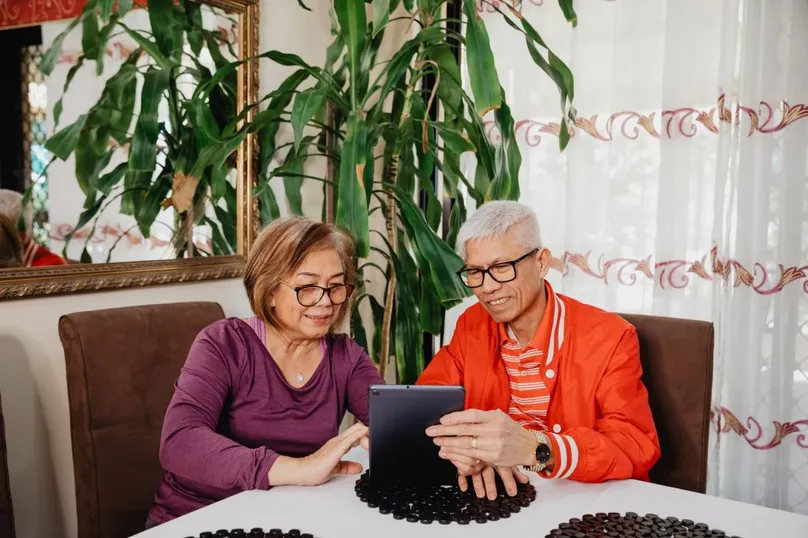
Read more Comfort articles
Did you enjoy this article? You may also like reading similar healthy ageing articles.
See all Comfort articles